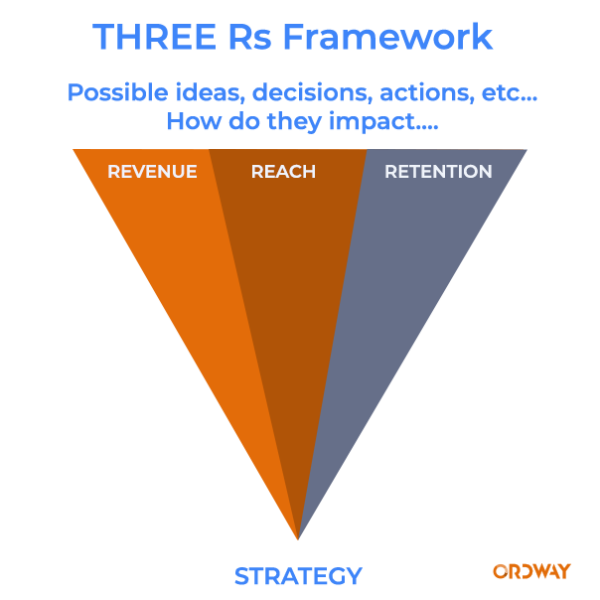I recently sat on a panel at the SaaSNorth conference in Ottawa. Sharing the stage with great Canadian tech leaders like Mallorie Broadie from Bridgit and Ralf Dagher from VEEM got me thinking about my transition from Product leader to the role of CEO.
One of the themes the panel covered was about how increasing responsibility and management within a product organization ultimately prepared me for the role of CEO. While there are certain CEO responsibilities that no one can quite be prepared for, like having the good fortune of debating valuations with investors, my product career, and the frameworks I used were incredibly helpful as I transitioned into my role as CEO of Ordway.
The Three Rs Framework (revenue, reach, and retention lenses) is perfect for product roadmaps and for running a business as CEO
I encourage our Product Managers to use the simple Three Rs framework which forces us to think about how a roadmap item impacts revenue, the possible reach of a feature to new customers, and how it affects our current customer base. If executed properly, these ideas translate to the decision making necessary to scale up a business. Let’s explore some real-world examples of how the three Rs framework plays out in today’s complex business environment.

Revenue lens (example — hiring, one of the most important functions of a CEO)
How will my decision as CEO affect the revenue generated by our service by making it easier to sell, create more value for customers, etc?
When you translate this to hiring, the revenue impact for the business development team is fairly straightforward. If you’ve laid a good foundation of data-driven decision making within the business side of the house, you should be able to estimate how the investment in headcount relates to expected future revenue (based on historical loaded CAC, sales cycle duration, upsells, etc).
On the product and engineering teams it is a little more opaque, but any hire you make needs to add to the skill set necessary to accomplish your vision. In Ordway’s case, we’re on a mission to eliminate manual workarounds in the sales-to-finance process. You have to balance hiring for today’s needs versus where you want the business to be in three years. For young companies, this is an easy exercise, but for established companies with legacy systems, this becomes a difficult task which is highlighted through Clayton Christensen’s work in the Innovator’s Dilemma. To me, this is similar to the prioritization and triage process a product organization uses to work through feature delivery and addressing tech debt. Once you get to a certain scale, tech debt can consume a disproportionate amount of company resources.
Finally, with regards to general operations, you want to be as efficient as possible so you can prioritize people in the value creation aspects of your business. This is where build vs buy becomes critically important to your business. Would you rather hire sales people and engineers, or a full-time benefits coordinator? Benefits attract and retain great talent, but they are a secondary enabler of company revenue. As such, you may want to buy a 3rd-party organization’s services that are better conceived than you could ever build yourself, to fill that need within the organization.
Reach lens (example — international expansion)
How will my decision as CEO affect the reach of our service by growing customer count, deepening a relationship with a customer, expand into new markets or verticals, etc?
At Ordway, we are fortunate to work with clients and customers around the world. However, this is not an easy decision to make for many companies. With modern telecommunications, getting to the meeting is not a problem. But, does your organization have the capacity to meet the requirements of serving a local market? One example from the billing and revenue automation space is asking if there are regulatory impediments to accomplishing your work? In Brazil, companies who send invoices need to work within the Boleto framework. It’s a must have to process invoices in Brazil. If you don’t have the capacity or wherewithal to generate the correct data, you shouldn’t spend time exploring partnerships with Brazilian companies. That time is a resource you never get back.
Retention lens (example — product)
How will my decision as CEO affect the retention of our service by our customers, the retention of our employees, etc?
CEOs need to think critically about how to minimize customer churn. This can take the form of customer surveys, evaluating good vs bad customers, offering more value over time, etc. In the world of B2B software, the industry is littered by the dead bodies of failed implementations. So, you need to think deeply about how your product delivers value for customers and how that impacts the retention of your customers. Is it about performing above your benchmarked competitors? Is it about increasing share of wallet, or is it moving upmarket and focusing on deeper integrations with fewer customers? Or, are you willing to have a product that has relatively high churn, but through the deployment of a freemium strategy, you can grab market share and hope that customers will ultimately pay you for your services.
We use the Three Rs framework of Revenue, Reach, and Retention to make many of our decisions across all functional areas within the organization.
Watch a five-minute video of the the Winning Product playbook panel from SaaSNorth. I talk about the Three Rs framework and much more.
Business & Finance Articles on Business 2 Community
(56)